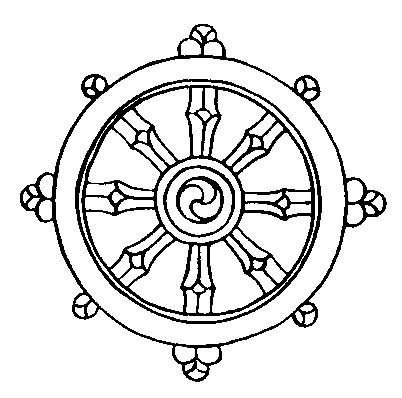 The Eightfold Path consists of eight aspects, each beginning with the word samyanc (in Sanskrit) or samma (in Pali), which is usually translated as 'right', and denotes a sense of 'ideal' or 'complete'. In some Buddhist traditions, the Eightfold Path is represented by an eight-spoked wheel called a dharma wheel. This represents the inter-relationship of all the elements, as they are not meant to be practiced in a certain order, but contemporaneously. Each Buddhist tradition interprets them slightly differently, emphasizing certain aspects over others, and many have separate interpretations for monks and laypersons.
The Eightfold Path consists of eight aspects, each beginning with the word samyanc (in Sanskrit) or samma (in Pali), which is usually translated as 'right', and denotes a sense of 'ideal' or 'complete'. In some Buddhist traditions, the Eightfold Path is represented by an eight-spoked wheel called a dharma wheel. This represents the inter-relationship of all the elements, as they are not meant to be practiced in a certain order, but contemporaneously. Each Buddhist tradition interprets them slightly differently, emphasizing certain aspects over others, and many have separate interpretations for monks and laypersons. The eight aspects are sometimes grouped into three divisions, particularly in Mahayana Buddhist traditions, and are presented as such here:
Wisdom Aspects
Right View or Right Understanding
- Understanding the nature and origin of suffering (the Four Noble Truths)
- Understanding karma
- Understanding the truth of impermanence
Right Intention or Right Determination
- Resolve to rid oneself of ignorance
- Correct renunciation (interpreted uniquely by each Buddhist tradition, and differently for laypersons and monks)
Ethical Aspects
Right Speech
- Using words carefully and morally
- Abstaining from lying and abusive speech
Right Action
- Moral conduct, in relation to oneself and others
- Abstaining from stealing, killing, and for monks/nuns, sexual activity
Right Livelihood
- Engaging in a livelihood that does not harm others
- Traditionally, the five businesses listed as harmful are those having to do with weapons, human trafficking, meat (part of the case for vegetarianism, for those Buddhist traditions that are vegetarian), poisons, and intoxicants.
Concentration Aspects
Right Effort
- Making the effort to cultivate the thoughts, words and deeds that further one's path
- Making the effort to destroy unwholesomeness in oneself and cultivate wholesomeness, including metta, or lovingkindness, and other benefic attributes
Right Mindfulness
- Right awareness or attention, in the present moment
- Self-awareness, or a constant watching of the mind and its tendencies
Right Concentration
- The kind of concentration, or samadhi, that leads to true meditative absorption, or jhana
- Traditionally, there are three main objects of concentration - breathing, visual objects, or mantras
An understanding of each of the eight elements deepens over time, and emphasis may shift from one to the other as a practitioner progresses, usually under the guidance of a teacher. In the Mahacattarisaka Sutta, the Buddha teaches that a proper understanding of all eight elements leads to the cultivation of two additional ones - Right Knowledge and Right Liberation. Right knowledge is direct insight into reality. Right liberation is awakening, and the ultimate fruit of practice.
Note that this article is included in the e-book Introduction to Buddhism and Buddhist Meditation.


